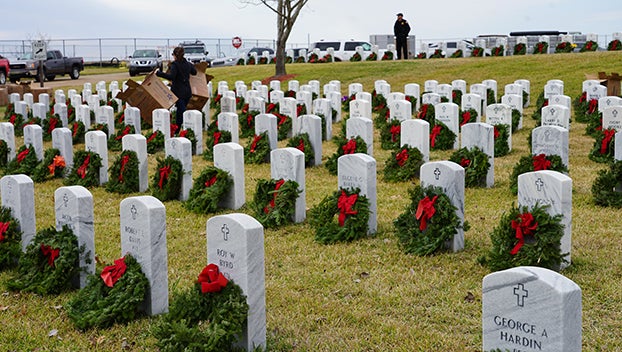Natchez complex exemplifies problems with public housing across country
Published 1:04 am Friday, April 12, 2019

- Destiny Johnson shows the broken door to her oven that she uses string to hold together, in her apartment in Cedarhurst Homes, a federally subsidized, low-income apartment complex in Natchez. The complex failed a health and safety inspection in each of the past three years. Upset with conditions, Johnson moved out in late March. (AP Photo/Rogelio V. Solis)
NATCHEZ (AP) — Cedarhurst Apartments was home, sweet home for one Natchez woman and her kids — until she got fed up and moved out last month.
Before she moved out, Destiny Johnson shared a government-funded apartment with her three small children and a legion of cockroaches.
They lurked in the medicine cabinet, under the refrigerator, behind a picture on the wall. The mother nudged a bedroom dresser and more roaches skittered away as her 2-year-old son stomped on them.
Inspectors had given the apartment complex failing health and safety scores for the past three years. Yet the federal government continued to pay Johnson’s rent at the property where a three-bedroom unit like hers can run $900 a month.
“I’m not asking for the best,” she told a reporter weeks before leaving, “but something better than this, especially for these kids.”
Health and safety inspection scores at taxpayer-funded apartments assigned to low-income tenants have been declining for years, typically with no serious consequences for landlords, an Associated Press analysis of federal housing data shows.
Johnson’s former apartment is one of nearly 160,000 at private properties with federal subsidy contracts that have failed at least one inspection since 1999.
Federal data shows that the vast majority of failing inspections in the private units involved urgent safety or health violations. In such apartments, tenants curse heaters that don’t heat, emergency exits that don’t open, windows that don’t close. They live with rats, rust, holes and mold.
In 2015 alone, families living in subsidized housing reported at least 155,000 more cases of childhood asthma than expected if the rate were the same as renters in other households, according to AP’s analysis of the American Housing Survey. Medical studies tie asthma to mold.
The U.S. Department of Housing and Urban Development subsidizes rents for 2.1 million low-income households assigned both to public housing and privately owned apartments such as Cedarhurst Homes, where Johnson lived.
Federal authorities acknowledge the long slide in inspection scores, which started a decade ago in the private housing. They say they have been trying to protect tenants by reinspecting sites with surprisingly high scores and closely monitoring repairs.
“These older properties,” Housing and Urban Development spokesman Brian Sullivan said, “the private owners may not have the means to do needed repairs.”
Another Cedarhurst Homes tenant, Whitley Williams, wanted to show a reporter and photographer her leaking water heater. The door to its closet was damp and swollen. She tried to heave it open, but the bottom scraped the floor and broke apart.
Federal records list the site owner as The Columbia Property Group. Company President Melanie Moe referred questions to Bryan King, an officer at Mississippi-based Triangle Development, LLC. In an emailed statement, he said his company was acquiring Cedarhurst Homes and planned to pursue federal tax credits for a “large renovation.”
Federally subsidized private apartments fare worst in Louisiana, where 12% of inspections gave failing grades, AP’s analysis shows. Mississippi was second at 10%.
Nationally, inspection scores at privately owned units reached a peak of 90 out of a possible 100 in 2007 during the George W. Bush administration. Scores averaged 86 during Barack Obama’s two terms and 81 under President Trump as of June.
HUD also subsidizes rents in public housing complexes, typically larger buildings run by state or local officials.
Largely due to blighted complexes in Baltimore, Maryland had the country’s highest inspection failure rate for public housing since 2013 at 32%. The District of Columbia was second at 29%.
“Steadily declining federal investment in public housing for more than a decade has taken a tremendous toll,” the Housing Authority of Baltimore City said in a statement.
Nationally, public housing inspection scores averaged 89 during Obama’s second term, dropping to 79 under Trump through March 2018.
Federal housing officials attribute the recent drops at least partly to their crackdown on substandard repairs and inflated inspection scores .
Michael Kane, executive director of the National Alliance of HUD Tenants, acknowledged the department has gotten tougher on inspections but said the decline in scores reflects continued deterioration of living conditions.
Some housing advocates say more subsidy vouchers should be distributed for a separate federal program that lets tenants pick a unit on the private market. Others suggest more tax credits for building and repairing low-income housing, more federal staff, and more tenant participation in site improvements.
Federal officials say they must think hard about any enforcement actions that might shutter a building. The federal government ended most of its efforts to build new low-cost housing in the 1980s.
“We lose the affordable housing forever. You never get it back,” agency spokesman Sullivan said.
Since the start of 2016, the agency has terminated 36 housing contracts, he said. The program has about 24,000.
Most failing sites get what amounts to a warning and multiple chances to correct violations.






